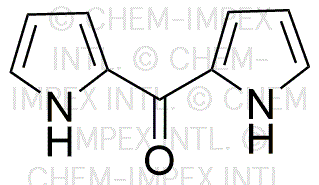5-Dipyrrylketone is widely utilized in research focused on:
- Coordination Chemistry: This compound serves as a versatile ligand in coordination complexes, enhancing the properties of metal ions in various applications, including catalysis and materials science.
- Fluorescent Probes: Its unique structure allows it to be used in the development of fluorescent probes for biological imaging, aiding researchers in visualizing cellular processes with high specificity.
- Organic Synthesis: 5-Dipyrrylketone is valuable in organic synthesis for creating complex molecules, offering a pathway to produce pharmaceuticals and agrochemicals efficiently.
- Electrochemical Sensors: The compound is employed in the fabrication of electrochemical sensors, providing sensitive detection of various analytes, which is crucial in environmental monitoring and food safety.
- Photovoltaic Devices: Its properties are harnessed in the development of organic photovoltaic devices, contributing to advancements in renewable energy technologies.
Informations générales
Propriétés
Sécurité et réglementation
Applications
5-Dipyrrylketone is widely utilized in research focused on:
- Coordination Chemistry: This compound serves as a versatile ligand in coordination complexes, enhancing the properties of metal ions in various applications, including catalysis and materials science.
- Fluorescent Probes: Its unique structure allows it to be used in the development of fluorescent probes for biological imaging, aiding researchers in visualizing cellular processes with high specificity.
- Organic Synthesis: 5-Dipyrrylketone is valuable in organic synthesis for creating complex molecules, offering a pathway to produce pharmaceuticals and agrochemicals efficiently.
- Electrochemical Sensors: The compound is employed in the fabrication of electrochemical sensors, providing sensitive detection of various analytes, which is crucial in environmental monitoring and food safety.
- Photovoltaic Devices: Its properties are harnessed in the development of organic photovoltaic devices, contributing to advancements in renewable energy technologies.
Documents
Fiches de données de sécurité (FDS)
La FDS fournit des informations de sécurité complètes sur la manipulation, le stockage et l’élimination du produit.
Spécifications du produit (PS)
Le PS fournit une description complète des propriétés du produit, notamment sa composition chimique, son état physique, sa pureté et les exigences de stockage. Il détaille également les plages de qualité acceptables et les applications prévues du produit.
Certificats d'analyse (COA)
Recherchez des certificats d'analyse (COA) en saisissant le numéro de lot du produit. Les numéros de lot et de lot se trouvent sur l'étiquette d'un produit, après les mots « Lot » ou « Lot de fabrication ».
Numéro de catalogue
Numéro de lot/série
Certificats d'origine (COO)
Ce certificat d'exploitation confirme le pays dans lequel le produit a été fabriqué, et détaille également les matériaux et composants utilisés et s'il est issu de sources naturelles, synthétiques ou autres sources spécifiques. Ce certificat peut être requis pour les douanes, le commerce et la conformité réglementaire.
Numéro de catalogue
Numéro de lot/série
Fiches de données de sécurité (FDS)
La FDS fournit des informations de sécurité complètes sur la manipulation, le stockage et l’élimination du produit.
DownloadSpécifications du produit (PS)
Le PS fournit une description complète des propriétés du produit, notamment sa composition chimique, son état physique, sa pureté et les exigences de stockage. Il détaille également les plages de qualité acceptables et les applications prévues du produit.
DownloadCertificats d'analyse (COA)
Recherchez des certificats d'analyse (COA) en saisissant le numéro de lot du produit. Les numéros de lot et de lot se trouvent sur l'étiquette d'un produit, après les mots « Lot » ou « Lot de fabrication ».
Numéro de catalogue
Numéro de lot/série
Certificats d'origine (COO)
Ce certificat d'exploitation confirme le pays dans lequel le produit a été fabriqué, et détaille également les matériaux et composants utilisés et s'il est issu de sources naturelles, synthétiques ou autres sources spécifiques. Ce certificat peut être requis pour les douanes, le commerce et la conformité réglementaire.


